High-Accuracy Mapping of Soil Parent Material Types in Hilly Areas at the County Scale Using Machine Learning Algorithms
Abstract
:1. Introduction
2. Materials and Methods
2.1. Study Area
2.2. Research Framework
2.3. Data Sources and Feature Extraction
2.4. Training Sample Selection
2.5. Machine Learning Algorithms for Parent Material Classification
2.6. Accuracy and Uncertainty Assessment of Parent Material Classification
2.7. Evaluation of Feature Importance
3. Results
3.1. Accuracy of Classification Models with Different Feature Combination Schemes
3.2. Comparison of Conventional and Digital Maps of Parent Material Types
3.3. Feature Importance for Parent Material Identification
4. Discussion
4.1. Contribution of Feature Variables to Soil Parent Material Classification
4.2. Comparison of Different Methods for Mapping of Soil Parent Material Types
4.3. Error Sources and Study Limitations
5. Conclusions
Author Contributions
Funding
Data Availability Statement
Conflicts of Interest
Abbreviations
Appendix A
| Feature Combination | RF | SVM | MLC | ||
|---|---|---|---|---|---|
| n_estimators | max_features | class_weight | max_iter | probability_threshold | |
| Gl | 565 | 6 | 1 | 1200 | 0.59 |
| Gm | 586 | 4 | 1 | 1200 | 0.68 |
| E | 475 | 5 | 1 | 1200 | 0.55 |
| S | 507 | 4 | 1 | 1200 | 0.68 |
| T | 519 | 4 | 1 | 1200 | 0.59 |
| N | 583 | 6 | 1 | 1200 | 0.66 |
| L | 440 | 6 | 1 | 1200 | 0.59 |
| GlT | 513 | 6 | 1 | 1300 | 0.70 |
| GlE | 551 | 7 | 1 | 1300 | 0.70 |
| GlS | 560 | 3 | 1 | 1300 | 0.66 |
| GlT | 482 | 4 | 1 | 1300 | 0.62 |
| GlN | 477 | 6 | 1 | 1300 | 0.67 |
| GlL | 532 | 3 | 1 | 1300 | 0.64 |
| GmE | 476 | 3 | 1 | 1300 | 0.63 |
| GmS | 474 | 5 | 1 | 1300 | 0.62 |
| GmT | 446 | 4 | 1 | 1300 | 0.54 |
| GmN | 479 | 3 | 1 | 1300 | 0.55 |
| GmL | 563 | 6 | 1 | 1300 | 0.58 |
| ES | 465 | 6 | 1 | 1300 | 0.53 |
| ET | 470 | 5 | 1 | 1300 | 0.56 |
| EN | 401 | 4 | 1 | 1300 | 0.67 |
| EL | 488 | 7 | 1 | 1300 | 0.76 |
| ST | 558 | 5 | 1 | 1300 | 0.71 |
| SN | 595 | 7 | 1 | 1300 | 0.75 |
| SL | 479 | 7 | 1 | 1300 | 0.65 |
| TN | 414 | 6 | 1 | 1300 | 0.75 |
| TL | 595 | 7 | 1 | 1300 | 0.70 |
| NL | 413 | 5 | 1 | 1300 | 0.72 |
| GlGmE | 469 | 3 | 1 | 1400 | 0.77 |
| GlGmS | 586 | 3 | 1 | 1400 | 0.67 |
| GlGmT | 491 | 4 | 1 | 1400 | 0.66 |
| GlGmN | 528 | 6 | 1 | 1400 | 0.68 |
| GlGmL | 556 | 5 | 1 | 1400 | 0.69 |
| GlGmES | 500 | 4 | 1 | 1400 | 0.70 |
| GlGmEN | 422 | 4 | 1 | 1400 | 0.68 |
| GlGmEL | 504 | 5 | 1 | 1400 | 0.65 |
| GlGmESN | 479 | 3 | 1 | 1300 | 0.70 |
| GlGmESL | 488 | 4 | 1 | 1300 | 0.72 |
| GlGmESTNL | 493 | 5 | 1 | 1300 | 0.75 |
References
- Jenny, H. Factors of Soil Formation; McGraw-Hill: New York, NY, USA, 1941. [Google Scholar]
- Richter, J.; Owens, P.R.; Libohova, Z.; Adhikari, K.; Fuentes, B. Mapping parent material as part of a nested approach to soil mapping in the Arkansas River Valley. CATENA 2019, 178, 100–108. [Google Scholar] [CrossRef]
- McBratney, A.; Santos, M.M.; Minasny, B. On digital soil mapping. Geoderma 2003, 117, 3–52. [Google Scholar] [CrossRef]
- Kirillova, N.P.; Sileova, T.M.; Ulyanova, T.Y.; Rozov, S.Y.; Smirnova, I.E. Digital large-scale soil parent material map of Chashnikovo Training and Experimental Soil Ecology Center, Moscow State University. Mosc. Univ. Soil Sci. Bull. 2017, 72, 93–99. [Google Scholar] [CrossRef]
- Heung, B.; Bulmer, C.E.; Schmidt, M.G. Predictive soil parent material mapping at a regional-scale: A Random Forest approach. Geoderma 2014, 214–215, 141–154. [Google Scholar] [CrossRef]
- Mello, F.A.; Bellinaso, H.; Mello, D.C.; Safanelli, J.L.; Mendes, W.D.S.; Amorim, M.T.; Gomez, A.M.; Poppiel, R.R.; Silvero, N.E.; Gholizadeh, A.; et al. Soil parent material prediction through satellite multispectral analysis on a regional scale at the Western Paulista Plateau, Brazil. Geoderma Reg. 2021, 26, e00412. [Google Scholar] [CrossRef]
- Jang, H.J.; Dobarco, M.R.; Minasny, B.; McBratney, A. Creating a soil parent material map digitally using a combination of interpretation and statistical techniques. Soil Res. 2021, 59, 684–698. [Google Scholar] [CrossRef]
- Zhu, A.X.; Liu, J.; Du, F.; Zhang, S.J.; Qin, C.Z.; Burt, J.; Behrens, T.; Scholten, T. Predictive soil mapping with limited sample data. Eur. J. Soil Sci. 2015, 66, 535–547. [Google Scholar] [CrossRef]
- Zhu, A.-X.; Band, L.E. A Knowledge-Based Approach to Data Integration for Soil Mapping. Can. J. Remote Sens. 1994, 20, 408–418. [Google Scholar] [CrossRef]
- Hengl, T.; De Jesus, J.M.; Heuvelink, G.B.M.; Gonzalez, M.R.; Kilibarda, M.; Blagotić, A.; Shangguan, W.; Wright, M.N.; Geng, X.; Bauer-Marschallinger, B.; et al. SoilGrids250m: Global gridded soil information based on machine learning. PLoS ONE 2017, 12, e0169748. [Google Scholar] [CrossRef]
- Brammer, H.; Hole, F.D.; Campbell, J.B. Soil Landscape Analysis. Geogr. J. 1985. [Google Scholar] [CrossRef]
- Li, J.; Chen, Y.; Zheng, L.; Jiao, X.; Sui, Y. Development of Soil Classification and Research Avenue. Soil Crop 2014, 3, 146–150. [Google Scholar]
- Zhu, A.; Yang, L.; Fan, N.; Zeng, C.; Zhang, G. The review and outlook of digital soil mapping. Prog. Geogr. 2018, 37, 66–78. [Google Scholar] [CrossRef]
- Gruber, F.E.; Baruck, J.; Mair, V.; Geitner, C. From geological to soil parent material maps—A random forest-supported analysis of geological map units and topography to support soil survey in South Tyrol. Geoderma 2019, 354, 113884. [Google Scholar] [CrossRef]
- Armstrong, J.E. Surficial Geology of Vancouver Area, British Columbia; Geological Survey of Canada: Ottawa, ON, Canada, 1956; paper 55. [Google Scholar]
- Armstrong, J.E. Surficial Geology of New Westminster Map-Area, British Columbia; Department of Mines and Technical Surveys: Ottawa, ON, Canada, 1957; Paper 57 and Map 16. [Google Scholar]
- Li, A.-D.; Guo, P.-T.; Wu, W.; Liu, H.-B. Impacts of terrain attributes and human activities on soil texture class variations in hilly areas, south-west China. Environ. Monit. Assess. 2017, 189, 281. [Google Scholar] [CrossRef]
- Zhang, D.; Zhou, F.; Fang, K.; Davi, N.; Chen, Z.; Wang, F.; Chen, Y. Quantification of soil erosion dynamics in the hilly red soil region of Southeast China based on exposed roots. CATENA 2023, 232, 107386. [Google Scholar] [CrossRef]
- Grimm, R.; Behrens, T.; Märker, M.; Elsenbeer, H. Soil organic carbon concentrations and stocks on Barro Colorado Island—Digital soil mapping using Random Forests analysis. Geoderma 2008, 146, 102–113. [Google Scholar] [CrossRef]
- Gray, J.M.; Bishop, T.F.; Wilford, J.R. Lithology and soil relationships for soil modelling and mapping. CATENA 2016, 147, 429–440. [Google Scholar] [CrossRef]
- Zeferino, L.B.; de Souza, L.F.T.; Amaral, C.H.D.; Filho, E.I.F.; de Oliveira, T.S. Does environmental data increase the accuracy of land use and land cover classification? Int. J. Appl. Earth Obs. Geoinf. 2020, 91, 102128. [Google Scholar] [CrossRef]
- Zhang, L.; Wang, Y.; Niu, M.; Wang, C.; Wang, Z. Machine learning for characterizing risk of type 2 diabetes mellitus in a rural Chinese population: The Henan Rural Cohort Study. Sci. Rep. 2020, 10, 4406. [Google Scholar] [CrossRef]
- Georganos, S.; Grippa, T.; Vanhuysse, S.; Lennert, M.; Shimoni, M.; Wolff, E. Very high resolution object-based land use–land cover urban classification using extreme gradient boosting. IEEE Geosci. Remote Sens. Lett. 2018, 15, 607–611. [Google Scholar] [CrossRef]
- Sheykhmousa, M.; Mahdianpari, M.; Ghanbari, H.; Mohammadimanesh, F.; Ghamisi, P.; Homayouni, S. Support vector machine versus random forest for remote sensing image classification: A meta-analysis and systematic review. IEEE J. Sel. Top. Appl. Earth Obs. Remote Sens. 2020, 13, 6308–6325. [Google Scholar] [CrossRef]
- Hengl, T.; Heuvelink, G.B.M.; Kempen, B.; Leenaars, J.G.B.; Walsh, M.G.; Shepherd, K.D.; Sila, A.; Macmillan, R.A.; De Jesus, J.M.; Tamene, L.; et al. Mapping soil properties of Africa at 250 m resolution: Random forests significantly improve current predictions. PLoS ONE 2015, 10, e0125814. [Google Scholar] [CrossRef]
- Lacoste, M.; Lemercier, B.; Walter, C. Regional mapping of soil parent material by machine learning based on point data. Geomorphology 2011, 133, 90–99. [Google Scholar] [CrossRef]
- Brevik, E.C.; Miller, B.A. The Use of Soil Surveys to Aid in Geologic Mapping with an Emphasis on the Eastern and Midwestern United States. Soil Horiz. 2015, 56, 1–9. [Google Scholar] [CrossRef]
- Miller, B.A.; Burras, C.L. Comparison of Surficial Geology Maps Based on Soil Survey and In Depth Geological Survey. Soil Horiz. 2015, 56, 1–12. [Google Scholar] [CrossRef]
- Oehlke, B.M.; Dolliver, H.A.S. Quaternary Glacial Mapping in Western Wisconsin Using Soil Survey Information. J. Nat. Resour. Life Sci. Educ. 2011, 40, 73–77. [Google Scholar] [CrossRef]
- Breiman, L. Random forests. Mach. Learn. 2001, 45, 5–32. [Google Scholar] [CrossRef]
- Heung, B.; Ho, H.C.; Zhang, J.; Knudby, A.; Bulmer, C.E.; Schmidt, M.G. An overview and comparison of machine-learning techniques for classification purposes in digital soil mapping. Geoderma 2016, 265, 62–77. [Google Scholar] [CrossRef]
- Adugna, T.; Xu, W.; Fan, J. Comparison of Random Forest and Support Vector Machine Classifiers for Regional Land Cover Mapping Using Coarse Resolution FY-3C Images. Remote Sens. 2022, 14, 574. [Google Scholar] [CrossRef]
- Mahmoud, R.R.; Mahmood, K.A.; Mahmoud, R.M. Maximum likelihood classification for land cover change detection utilizing lands at-8 imagery in Wasit Governorate, I.R.A.Q. Ecol. Environ. Conserv. 2019, 25, 68–72. [Google Scholar]
- Lan, J.J.; Yu, H.Y.; Chen, L.; Ma, H.H.; Zhang, H.Y. Scaling effect of airborne LiDAR DEM in watershed hydrological analysis and simulation. Surv. Mapp. Bull. 2020, 2020, 40–46. [Google Scholar] [CrossRef]
- de Oliveira, M.F.; Ortiz, B.V.; Morata, G.T.; Jiménez, A.-F.; Rolim, G.d.S.; da Silva, R.P. Training Machine Learning Algorithms Using Remote Sensing and Topographic Indices for Corn Yield Prediction. Remote Sens. 2022, 14, 6171. [Google Scholar] [CrossRef]
- Tang, G.; Yang, X.; Zhou, C.; Li, F.; Xiong, L.; Li, S.; Na, J. Nanjing Normal University. 2023. Global Basic Landform Units Datasets (2023), Version 1. Yangtze River Delta Science Data Center, National Earth System Science Data Sharing Infrastructure, National Science & Technology Infrastructure of China. Available online: http://geodata.nnu.edu.cn/ (accessed on 21 June 2023).
- Walker, D.A. Hierarchical subdivision of Arctic tundra based on vegetation response to climate, parent material and topography. Glob. Chang. Biol. 2000, 6, 19–34. [Google Scholar] [CrossRef]
- Zhang, L.; Gong, Z.; Wang, Q.; Jin, D.; Wang, X. Wetland mapping of Yellow River Delta wetlands based on multi-feature optimization of Sentinel-2 images. J. Remote Sens. 2019, 23, 313–326. [Google Scholar] [CrossRef]
- Liu, Y.; Li, Z.; Chen, Y.; Li, Y.; Li, H.; Xia, Q.; Kayumba, P.M. Evaluation of consistency among three NDVI products applied to High Mountain Asia in 2000–2015. Remote Sens. Environ. 2022, 269, 112821. [Google Scholar] [CrossRef]
- Peng, X.; He, G.; She, W.; Zhang, X.; Wang, G.; Yin, R.; Long, T. A Comparison of Random Forest Algorithm-Based Forest Extraction with GF-1 WFV, Landsat 8 and Sentinel-2 Images. Remote Sens. 2022, 14, 5296. [Google Scholar] [CrossRef]
- Qi, F.; Zhu, A.-X. Knowledge discovery from soil maps using inductive learning. Int. J. Geogr. Inf. Sci. 2003, 17, 771–795. [Google Scholar] [CrossRef]
- Qi, F. Knowledge Discovery from Area-Class Resource Maps: Data Preprocessing for Noise Reduction. Trans. GIS 2004, 8, 297–308. [Google Scholar] [CrossRef]
- Grinand, C.; Arrouays, D.; Laroche, B.; Martin, M.P. Extrapolating regional soil landscapes from an existing soil map: Sampling intensity, validation procedures, and integration of spatial context. Geoderma 2008, 143, 180–190. [Google Scholar] [CrossRef]
- Basheer, S.; Wang, X.; Farooque, A.A.; Nawaz, R.A.; Liu, K.; Adekanmbi, T.; Liu, S. Comparison of Land Use Land Cover Classifiers Using Different Satellite Imagery and Machine Learning Techniques. Remote Sens. 2022, 14, 4978. [Google Scholar] [CrossRef]
- Atienza, R. Advanced Deep Learning with Keras: Apply Deep Learning Techniques, Autoencoders, GANs, Variational Autoencoders, Deep Reinforcement Learning, Policy Gradients, and More; Packt Publishing Ltd.: Birmingham, UK, 2018. [Google Scholar]
- Congalton, R.G.; Green, K. Assessing the Accuracy of Remotely Sensed Data: Principles and Practices, 3rd ed.; Taylor & Francis Group: Boca Raton, FL, USA, 2019. [Google Scholar]
- Zhou, T.; Geng, Y.; Chen, J.; Pan, J.; Haase, D.; Lausch, A. High-resolution digital mapping of soil organic carbon and soil total nitrogen using DEM derivatives, Sentinel-1 and Sentinel-2 data based on machine learning algorithms. Sci. Total. Environ. 2020, 729, 138244. [Google Scholar] [CrossRef]
- Brus, D.; Kempen, B.; Heuvelink, G. Sampling for validation of digital soil maps. Eur. J. Soil Sci. 2011, 62, 394–407. [Google Scholar] [CrossRef]
- Lundberg, S.M.; Lee, S.I. A unified approach to interpreting model predictions. arXiv 2017, arXiv:1705.07874. [Google Scholar]
- Halim, M.K.; Ahmad, A.; Rahman, M.Z.; Amin, Z.M.; Khanan, M.F.; Musliman, I.; Kadir, W.H.W.; Jamal, M.H.; Maimunah, D.S.; Wahab, A.K.; et al. Land use/land cover mapping for conservation of UNESCO Global Geopark using object and pixel-based approaches. IOP Conf. Ser. Earth Environ. Sci. 2018, 169, 012075. [Google Scholar] [CrossRef]
- Tazikeh, H.; Khormali, F.; Amini, A.; Motlagh, M.B.; Ayoubi, S. Soil-parent material relationship in a mountainous arid area of Kopet Dagh basin, North East Iran. CATENA 2017, 152, 252–267. [Google Scholar] [CrossRef]
- Da Silva, M.S.; Guimarães, J.T.; Filho, P.W.S.; Júnior, W.N.; Sahoo, P.K.; Da Costa, F.R.; Júnior, R.O.S.; Rodrigues, T.M.; Da Costa, M.F. Morphology and morphometry of upland lakes over lateritic crust, Serra dos Carajás, southeastern Amazon region. An. Da Acad. Bras. De Ciências 2018, 90, 1309–1325. [Google Scholar] [CrossRef]
- Zhu, X.; Liang, Y.; Qu, L.; Cao, L.; Tian, Z.; Liu, T.; Li, M. Characteristics of runoff and sediment yield for two typical erodible soils in southern China. Int. J. Sediment Res. 2022, 37, 653–661. [Google Scholar] [CrossRef]
- Wu, H.; Song, X.; Liu, F.; Li, D.; Zhang, G. Geophysical and geochemical characterization reveals topography controls on critical zone structure in a low hilly region. Earth Surf. Process. Landf. 2022, 47, 2796–2810. [Google Scholar] [CrossRef]
- Dematte, J.A.M.; Huete, A.R.; Ferreira, L.G., Jr.; Nanni, M.R.; Alves, M.C.; Fiorio, P.R. Methodology for Bare Soil Detection and Discrimination by Landsat TM Image. Open Remote Sens. J. 2009, 2, 24–35. [Google Scholar] [CrossRef]
- Izawa, M.R.; Cloutis, E.A.; Rhind, T.; Mertzman, S.A.; Applin, D.M.; Stromberg, J.M.; Sherman, D.M. Spectral reflectance properties of magnetites: Implications for remote sensing. Icarus 2019, 319, 525–539. [Google Scholar] [CrossRef]
- Silva, L.S.; Júnior, J.M.; Barrón, V.; Gomes, R.P.; Teixeira, D.D.B.; Siqueira, D.S.; Vasconcelos, V. Spatial variability of iron oxides in soils from Brazilian sandstone and basalt. CATENA 2019, 185, 104258. [Google Scholar] [CrossRef]
- Bonfatti, B.R.; Demattê, J.A.; Marques, K.P.; Poppiel, R.R.; Rizzo, R.; Mendes, W.d.S.; Silvero, N.E.; Safanelli, J.L. Digital mapping of soil parent material in a heterogeneous tropical area. Geomorphology 2020, 367, 107305. [Google Scholar] [CrossRef]
- Mancini, M.; Weindorf, D.C.; Chakraborty, S.; Silva, S.H.G.; dos Santos Teixeira, A.F.; Guilherme, L.R.G.; Curi, N. Tracing tropical soil parent material analysis via portable X-ray fluorescence (pXRF) spectrometry in Brazilian Cerrado. Geoderma 2019, 337, 718–728. [Google Scholar] [CrossRef]
- Richer-De-Forges, A.C.; Chen, Q.; Baghdadi, N.; Chen, S.; Gomez, C.; Jacquemoud, S.; Martelet, G.; Mulder, V.L.; Urbina-Salazar, D.; Vaudour, E.; et al. Remote Sensing Data for Digital Soil Mapping in French Research—A Review. Remote Sens. 2023, 15, 3070. [Google Scholar] [CrossRef]
- Nussbaum, S.; Niemeyer, I.; Canty, M. SEATH—A New Tool for Automated Feature Extraction in the Context of Object-Based Image Analysis. In Proceedings of the 1st International Conference on Object-Based Image Analysis (OBIA 2006), Salzburg, Austria, 4–5 July 2006. [Google Scholar]
- Qi, Y. Random forest for bioinformatics. Ensemble Mach. Learn. Methods Appl. 2012, 4, 307–323. [Google Scholar] [CrossRef]
- Xie, G.; Niculescu, S. Mapping and Monitoring of Land Cover/Land Use (LCLU) Changes in the Crozon Peninsula (Brittany, France) from 2007 to 2018 by Machine Learning Algorithms (Support Vector Machine, Random Forest, and Convolutional Neural Network) and by Post-classification Comparison (PCC). Remote Sens. 2021, 13, 3899. [Google Scholar] [CrossRef]
- Sothe, C.; De Almeida, C.M.; Schimalski, M.B.; La Rosa, L.E.C.; Castro, J.D.B.; Feitosa, R.Q.; Dalponte, M.; Lima, C.L.; Liesenberg, V.; Miyoshi, G.T.; et al. Comparative performance of convolutional neural network, weighted and conventional support vector machine and random forest for classifying tree species using hyperspectral and photogrammetric data. GIScience Remote Sens. 2020, 57, 369–394. [Google Scholar] [CrossRef]
- Sevani, N.; Azizah, K.; Jatmiko, W. A Feature-based Transfer Learning to Improve the Image Classification with Support Vector Machine. Int. J. Adv. Comput. Sci. Appl. 2023, 14, 291–301. [Google Scholar] [CrossRef]
- Ahmad, A.; Kalsom, U.; Mohd, O.; Mawardy, M.; Sakidin, H.; Wahid, A.; Firdaus, S. Comparative Analysis of Support Vector Machine, Maximum Likelihood and Neural Network Classification on Multispectral Remote Sensing Data. Int. J. Adv. Comput. Sci. Appl. 2018, 9, 529–537. [Google Scholar] [CrossRef]
- Verbovšek, T.; Popit, T. GIS-assisted classification of litho-geomorphological units using Maximum Likelihood Classification, Vipava Valley, SW Slovenia. Landslides 2018, 15, 1415–1424. [Google Scholar] [CrossRef]
- Zhong, L.; Guo, X.; Xu, Z.; Ding, M. Soil properties: Their prediction and feature extraction from the LUCAS spectral library using deep convolutional neural networks. Geoderma 2021, 402, 115366. [Google Scholar] [CrossRef]
- Cahyana, D.; Sulaeman, Y.; Barus, B.; Darmawan; Mulyanto, B. Improving digital soil mapping in Bogor, Indonesia using parent material information. Geoderma Reg. 2023, 33, e00627. [Google Scholar] [CrossRef]
- Lagacherie, P.; McBratney, A. Spatial soil information systems and spatial soil inference systems: Perspectives for digital soil mapping. Dev. Soil Sci. 2007, 31, 3–24. [Google Scholar]
- Nadi, S.; Shojaei, D.; Ghiasi, Y. Accuracy Assessment of DEMs in Different Topographic Complexity Based on an Optimum Number of GCP Formulation and Error Propagation Analysis. J. Surv. Eng. 2020, 146, 04019019. [Google Scholar] [CrossRef]
- Liu, J.; Zhu, A.; Zhang, S.; Qin, C. Large-scaled soil attribute mapping method based on individual representativeness of sample sites. Acta Pedologica Sinica 2013, 50, 12–20. [Google Scholar]
- Zhong, L.; Guo, X.; Guo, J.X.; Xu, Z.; Zhu, Q.; Ding, M. Hyperspectral estimation of organic matter in red soil using different convolutional neural network models. Trans. Chin. Soc. Agric. Eng. 2021, 37, 203–212. [Google Scholar] [CrossRef]
- De Bem, P.P.; de Carvalho Junior, O.A.; Fontes Guimarães, R.; Trancoso Gomes, R.A. Change Detection of Deforestation in the Brazilian Amazon Using Landsat Data and Convolutional Neural Networks. Remote Sens. 2020, 12, 901. [Google Scholar] [CrossRef]
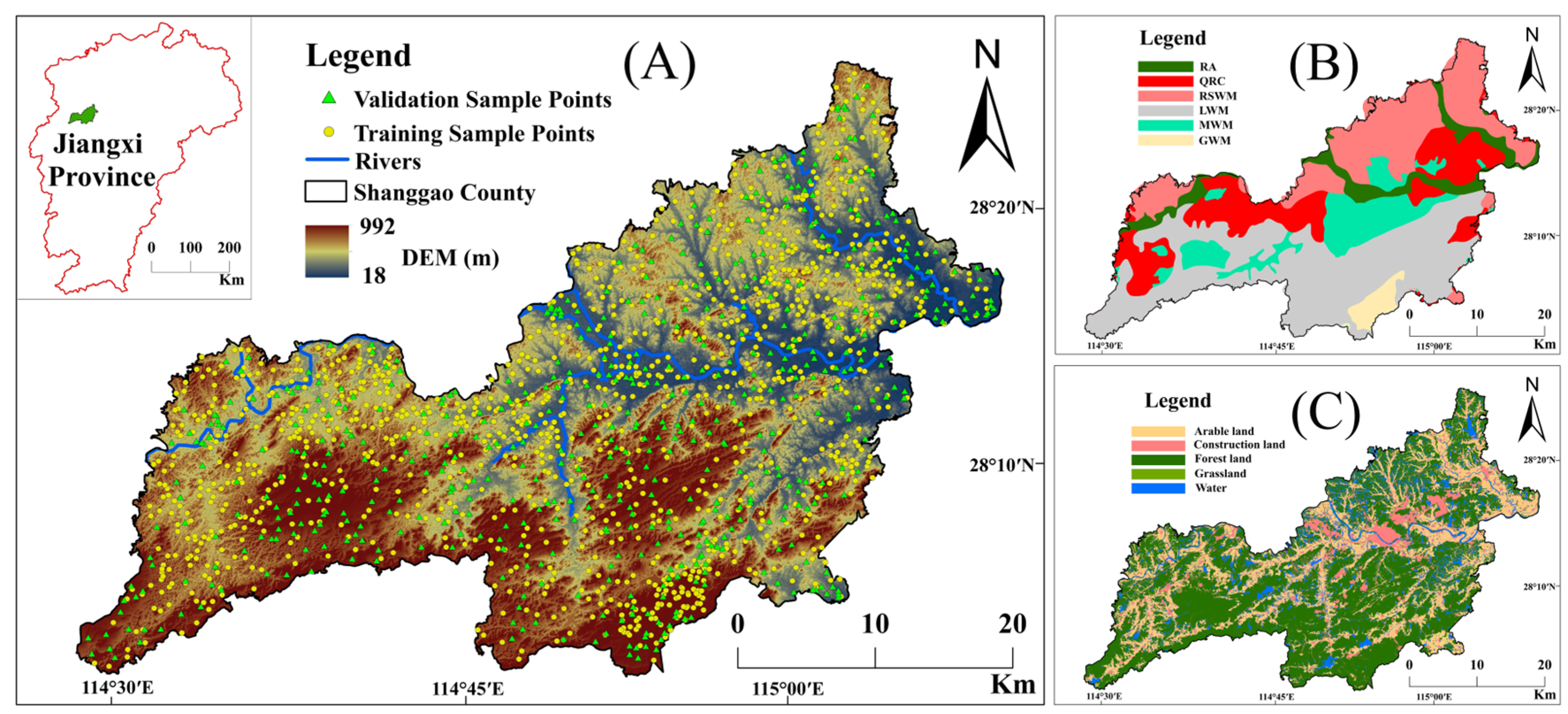
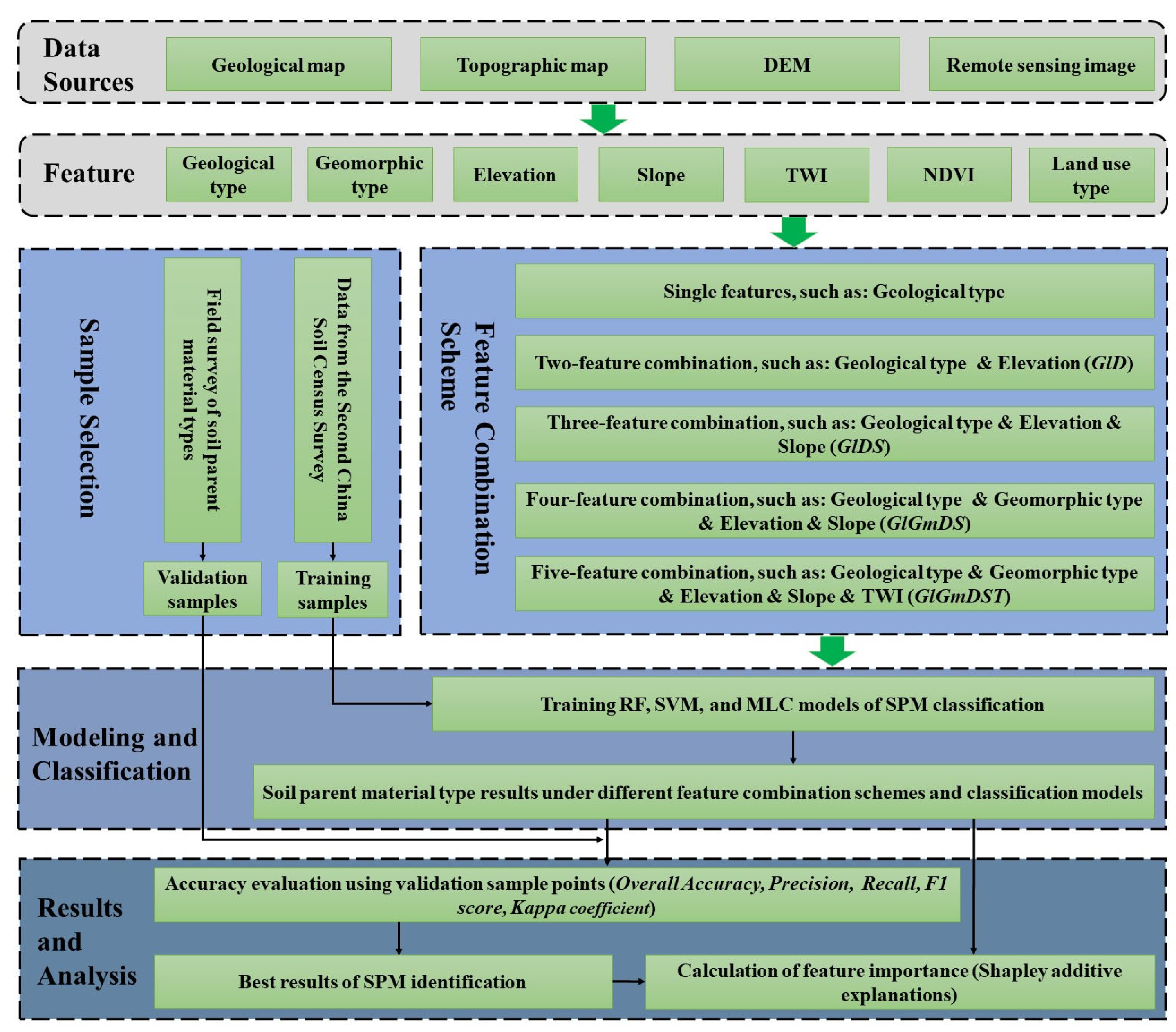
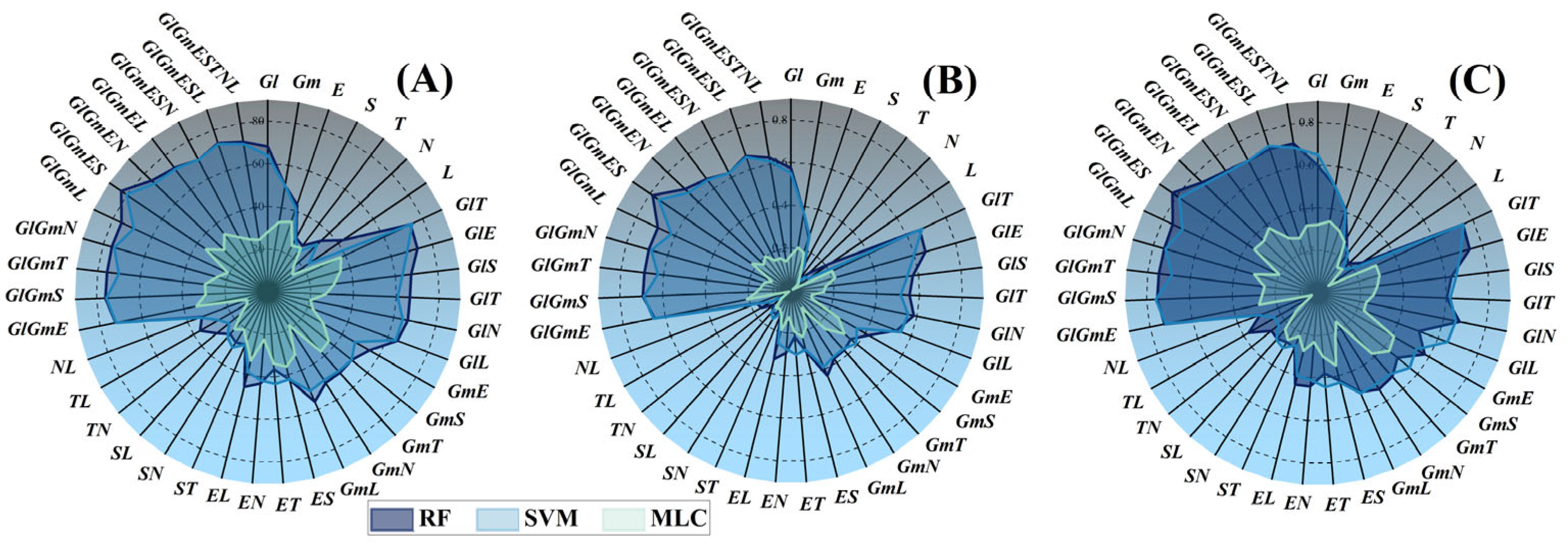


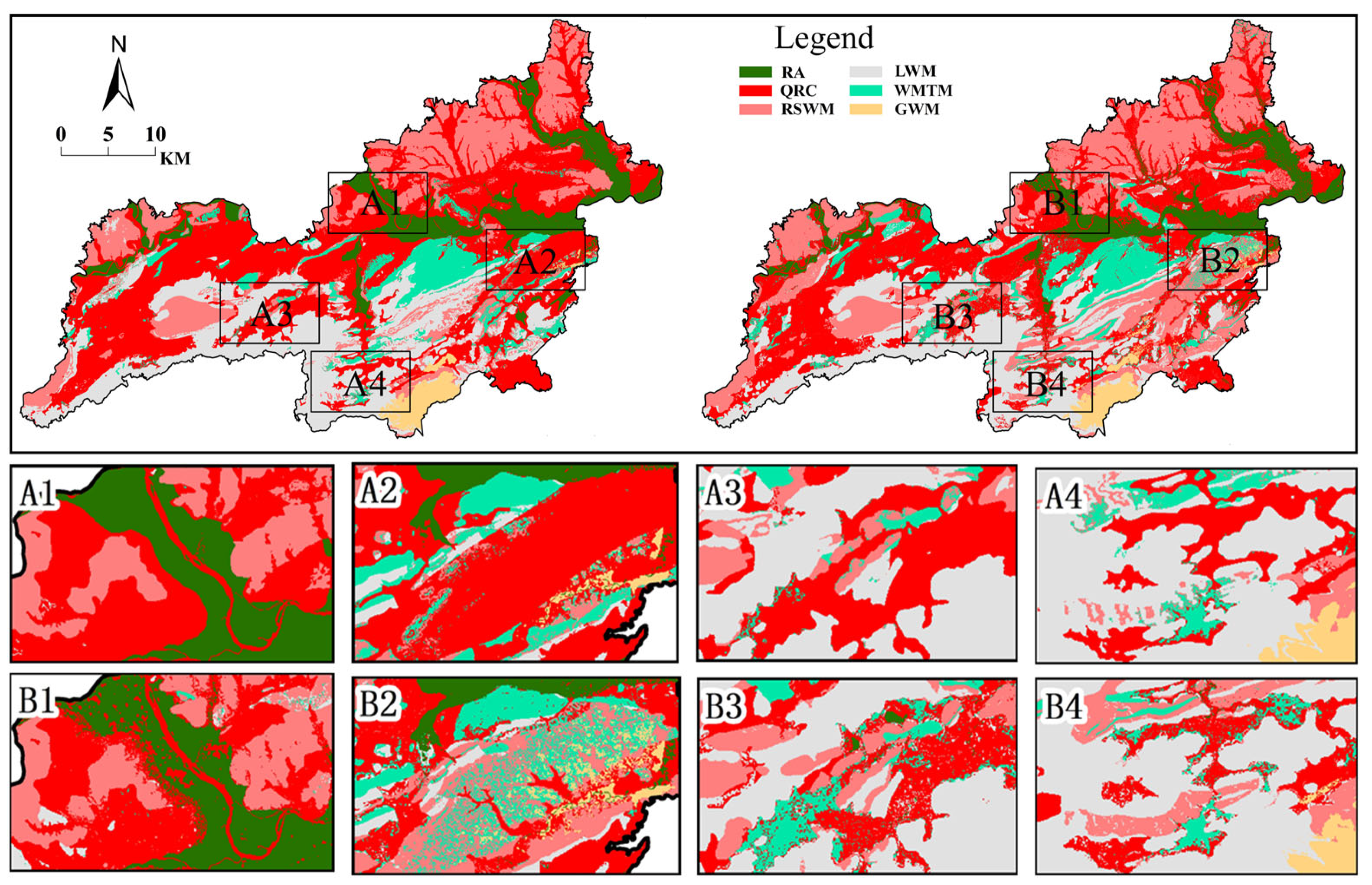
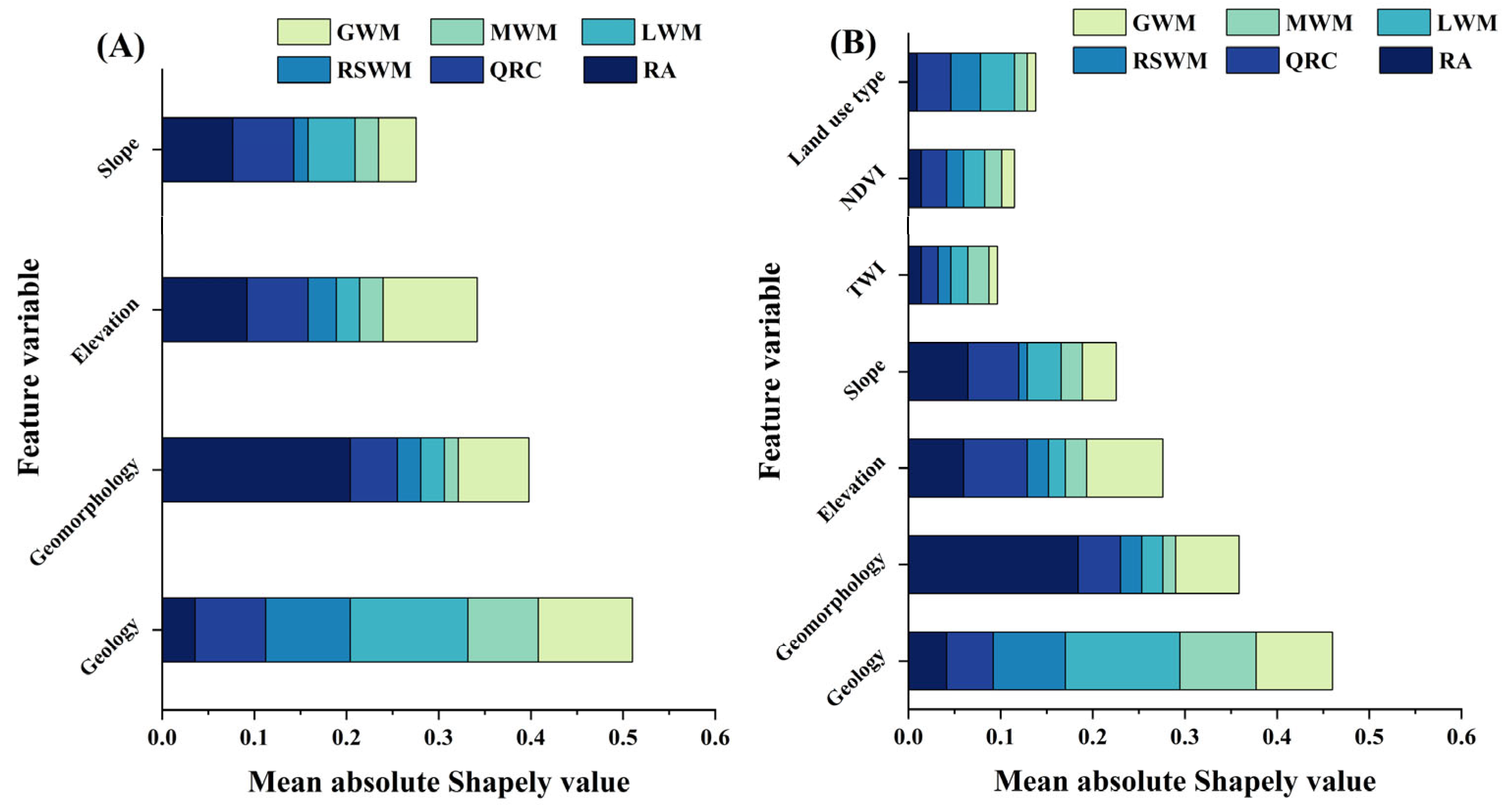
| Assessed Value | GlGmES-RF | GlGmES-SVM | ||
|---|---|---|---|---|
| OA/% | Kappa | OA/% | Kappa | |
| Mean value | 82.97 | 0.78 | 80.02 | 0.74 |
| Standard deviation | 0.047 | 0.019 | 0.053 | 0.023 |
| Maximum value | 83.67 | 0.83 | 81.13 | 0.71 |
| Minimum value | 82.14 | 0.77 | 79.12 | 0.78 |
| SPM Type | GlGmES-RF | GlGmES-SVM | Conventional Map | |||
|---|---|---|---|---|---|---|
| Area/hm2 | Ratio/% | Area/hm2 | Ratio/% | Area/hm2 | Ratio/% | |
| River alluvium | 12,608.64 | 9.35 | 11,485.53 | 8.52 | 9833.27 | 7.29 |
| Quaternary red clay | 39,238.11 | 29.10 | 46,607.40 | 34.57 | 24,062.67 | 17.85 |
| Red sandstone weathered material | 36,601.29 | 27.15 | 36,410.31 | 27.01 | 30,928.41 | 22.94 |
| Limestone weathered material | 23,836.50 | 17.68 | 25,039.08 | 18.57 | 49,662.79 | 36.83 |
| Weathered mudstone material | 18,467.91 | 13.70 | 12,087.27 | 8.97 | 17,192.53 | 12.75 |
| Granite weathered material | 4074.21 | 3.02 | 3197.07 | 2.37 | 3147.00 | 2.33 |
Disclaimer/Publisher’s Note: The statements, opinions and data contained in all publications are solely those of the individual author(s) and contributor(s) and not of MDPI and/or the editor(s). MDPI and/or the editor(s) disclaim responsibility for any injury to people or property resulting from any ideas, methods, instructions or products referred to in the content. |
© 2023 by the authors. Licensee MDPI, Basel, Switzerland. This article is an open access article distributed under the terms and conditions of the Creative Commons Attribution (CC BY) license (https://creativecommons.org/licenses/by/4.0/).
Share and Cite
Zeng, X.; Guo, X.; Jiang, Y.; Li, W.; Guo, J.; Zhou, Q.; Zou, H. High-Accuracy Mapping of Soil Parent Material Types in Hilly Areas at the County Scale Using Machine Learning Algorithms. Remote Sens. 2024, 16, 91. https://doi.org/10.3390/rs16010091
Zeng X, Guo X, Jiang Y, Li W, Guo J, Zhou Q, Zou H. High-Accuracy Mapping of Soil Parent Material Types in Hilly Areas at the County Scale Using Machine Learning Algorithms. Remote Sensing. 2024; 16(1):91. https://doi.org/10.3390/rs16010091
Chicago/Turabian StyleZeng, Xueliang, Xi Guo, Yefeng Jiang, Weifeng Li, Jiaxin Guo, Qiqing Zhou, and Hengyu Zou. 2024. "High-Accuracy Mapping of Soil Parent Material Types in Hilly Areas at the County Scale Using Machine Learning Algorithms" Remote Sensing 16, no. 1: 91. https://doi.org/10.3390/rs16010091
APA StyleZeng, X., Guo, X., Jiang, Y., Li, W., Guo, J., Zhou, Q., & Zou, H. (2024). High-Accuracy Mapping of Soil Parent Material Types in Hilly Areas at the County Scale Using Machine Learning Algorithms. Remote Sensing, 16(1), 91. https://doi.org/10.3390/rs16010091







